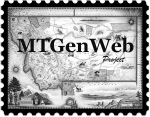CITY & TOWN HISTORIEs
BASIN CITY
Basin City, the rival of the town of Cataract, was founded by Lawson & Allport, in 1880, at the mouth of Basin creek, a tributary of Boulder river. Among the mines of the district are the Mantle, Boulder, Custer, Independence, Martin Maginnis, Rock of Ages, Nabob, Boston, Big Medicine, Susie Brown, Mohawk, Mount Thompson, Captain Cook, Mountain Chief, Saginaw, Katie, Silver Butte, Union, Clipper, Highland, Gib, and others. Basin City was once a camp of enterprise, and had its full share in contributing to the building up of the Territory. Owing to the new and more easily worked mines being discovered, Basin was left over, as it were, for the era of new development, new machinery and increased production. That it will eclipse its olden greatness is only a matter of a short time. The business circle is made up as follows: Thomas Bassett and Truman Hopkins, liquors; Amos Calvin, hotel; T. F. Murray, general merchant; D. D. Jackson, postmaster. The gold and silver ore mills at this mining point are worked.
Source: Transcription by Ellen Rae Thiel, from the book, History of Montana: 1739-1885, by M. A. Leeson, published in 1885; located on the website, Hathitrust Digital Library (http://www.hathitrust.org).
BEAVER CREEK
Beaver Creek is the name given to the center of this great stock range. The hamlet is 18 miles southeast of Helena, at the point where the water of the creek is diverted into the two French Bar ditches. The name Beavertown is also applied to this settlement, and under this name the census enumerator credited the place with a population of 14 in 1880. The discovery of lodes at this point and in the Park during the years 1878-9, added to the advances made in mining, will doubtless lead to the development of this district. The commercial community is made up as follows: M. M. Brooks, carpenter; Crahn & Marks, sawmill; Hanlay Bros., sawmill; C. Reynolds, hotel; Tuckes & McPherson, hotel; J. W. Shoffs, meat market; W. H. Ridgeway, blacksmith; John Robinson, wagonmaker, and J. N. Kelly, postmaster.
Source: Transcription by Ellen Rae Thiel, from the book, History of Montana: 1739-1885, by M. A. Leeson, published in 1885; located on the website, Hathitrust Digital Library (http://www.hathitrust.org).
BOULDER
The Boulder Town Company was incorporated February 8, 1865, almost three years after the first settlement, with N. Walls, president; G. W. Case, secretary; W. Berkins, treasurer; H. Stevens, R. Heaton and J. J. Healy, trustees. The boundaries of the town were "Commencing at the north side of Boulder crossing, on the Gillett road, thence north one half mile, thence west one mile, thence south one half mile, thence east one mile to the place of beginning, containing three hundred and twenty acres." The stampede from Gold creek to the Boulder, which took place July 20, 1862, was the origin of the village. The vicissitudes of the village are known to every old resident of the territory. Until the revival of mining the old town was almost forgotten, but with the new industrial era it has sprung once more into active life, and with so much earnestness, that she won from the rival towns the County Seat. The population of the village and vicinity in 1880 was 215. In July, 1883, the number of inhabitants in the town was about 150. The business circle of the town in 1883 comprised the following named citizens: R. W. Jeffries, T. F. Murray, Edward Dougherty, William Reins, William Deacy, J. G. Smith, V. A. Cook, F. Farnham, proprietor of the Boulder City Hotel. Boulder is the dinner station for three stage divisions; one from Butte, one from Helena and one from Dillon. In 1884-5 general stores were kept by V. A. Cook, J. E. Dougherty, R. W. Jeffries and T. F. Murray; hotel by F. Farnham, saloons by W. Deacy and J. G. Smith, livery by W. D. Northrop, blacksmith shop by W. Reins, and meat market by Murray & Davis.
The Australian, Belle of Boulder, Amazon, Wall Street, Ollie, Chillicothe, Emmett and Spencer lodes are all in this district. The Amazon concentrating works, two miles from the Amazon, were erected in 1883 by Jacob Wave, the mill-builder. Henry Thompson was granted $2,500 by the Legislature January 11, 1865, for the pursuit of G. Kelly, the murderer of R. R. Dorsett and John White on the Boulder. Boulder Star Lodge, No. 3, I. O. G. T., was organized February 18, 1869. The present number of members is fifty-one, including the following named officers of the lodge: G. W. Rohrbacker, Elmer Douglass, T. B. Mills, J. A. Bailey, G. A. Douglass, S. A. Riley, V. A. Cook, J. R. Holt and J. M. D. Holt.
From Boulder City excellent roads diverge in every direction, east to Elkhorn, southeast to Gallatin City, south to Dillon, west to Butte City, northwest to Comet and Wickes, and north to Jefferson and Helena, the several distances being: to Elkhorn, 15 miles; Gallatin, 40 miles; Butte City, 35 miles; Comet, 6 miles; Wickes, 9 miles; Jefferson, 12 miles; Helena, 32 miles. South of Boulder City two and a half miles are the famous Boulder Hot Springs, a favorite resort for invalids, the waters of which are held on high authority to be a specific in cases of rheumatic and scrofulous diseases and highly beneficial in nearly all chronic complaints. A large hotel building was completed at the springs in 1883.
Source: Transcription by Ellen Rae Thiel, from the book, History of Montana: 1739-1885, by M. A. Leeson, published in 1885; located on the website, Hathitrust Digital Library (http://www.hathitrust.org).

